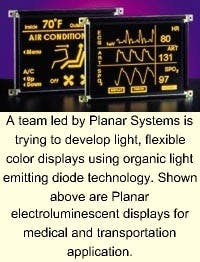By John Rhea
BEAVERTON, Ore. — Light-emitting diodes, or LEDs, represent a display technology that has fallen into disuse since it launched the era of digital watches and other consumer electronics 30 years ago. Today it is getting a fresh look from military researchers.
Planar Systems Inc. of Beaverton, Ore., is the prime contractor and system integrator of a team working under supervision of the Defense Advanced Research Projects Agency (DARPA) in Arlington, Va., to investigate active-matrix organic (carbon-based) LEDs, using N- and P-type materials, for a new generation of military displays.
The team received a $6 million contract from DARPA in June to advance organic LED (OLED) technology for possible use in military applications in which current display technologies suffer fundamental limitations.
Cathode ray tubes, or CRTs, represent a mature technology but are fragile and use much power. Liquid crystal displays, or LCDs, solve those problems — so well, in fact, that they have driven LEDs out of most consumer electronics. Still, LCDs have poor viewing angles and need heaters at low temperatures. Electroluminescent displays, meanwhile, are difficult to produce as color displays.
Members of the Planar team are preparing to demonstrate full-color OLEDs in a quarter-VGA format by October 2001, says Patrick Green, the company's project manager. The team's long-term goal is to design large color OLEDs that assembly lines can fabricate as commodity products.
Since the new LEDs also have considerable commercial potential, military users can expect to reap the cost savings of commercial off-the-shelf (COTS) technology.
Ching Tang conducted the original research on the polymer devices at the Eastman Kodak laboratories in Rochester, N.Y., in the 1980s. Japanese consumer electronics firms were the first to bring products to market.
In 1997 engineers at Pioneer Electronics Corp. in Tokyo introduced an FM radio, which was sold only in Japan, that used OLEDs in a 256-by-64-element green monochromatic screen to display text. The company followed that up with a color prototype in 1998. Last year experts at Sanyo Electric Co. Ltd. in Osaka, Japan, jumped in with another full-color display with sizes as large as five inches for use in car stereos.
Planar's Green says he anticipates that U.S. designers first will use OLEDs in cellular phones and car radios. Where the crossover from COTS to military markets is likely to occur is in hand-held devices such as global positioning system (GPS) receivers. OLEDs and LCDs already are low-power devices, but OLEDs are emissive devices and offer wider viewing angles than do LCDs.
Other members of the Planar team include 3M Co. in Waltham, Mass. (the former Polaroid facility), which will produce the materials; Princeton University in Princeton, N.J., whose scientists have conducted previous academic research; and two facilities of Rockwell International: the Collins Division in Cedar Rapids, Iowa, which will provide end-user input, and the Science Center in Thousand Oaks, Calif., which will fabricate the devices.
In parallel with this effort, DARPA officials have awarded a $1 million contract to Universal Display Corp. in Ewing, N.J., also to demonstrate quarter-VGA format flexible OLEDs. Additional contracts are expected.
Planar, an across-the-board supplier of CRT, LCD, and electroluminescent displays, has conducted its own DARPA- and company-funded research on OLEDs with an eye toward making them a commodity product. What is necessary, Green explains, is to create the infrastructure in which to make the OLEDs initially in batches and then in a continuous process, much the way the semiconductor industry produces random access memories (RAMs).
A key aspect of the research effort is to make flexible OLEDs that manufacturers can produce in rolls and tailor them to the needs of weapon systems. This means light, rugged, and flexible plastic substrates for military applications currently hampered by displays based on glass.
The second phase of the DARPA effort is due to address these enhancements, which is scheduled to begin in early 2002 after the contractors in the initial phase have demonstrated their prototypes. The OLEDs in this phase would also be 15 inches diagonal, with a resolution of at least 1,024 by 768 picture elements.

